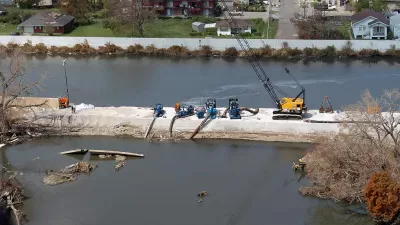Can Louisiana lawmakers succeed in retroactively overthrowing a lawsuit by the Southeast Louisiana Flood Protection Authority against 97 oil and gas companies, all while the state's coastline continues to disappear at alarming rates?
"The coast of Louisiana is crumbling into the Gulf of Mexico at an alarming rate. Over the last 80 years, it’s lost nearly 2,000 square miles. That’s as big as all of Rhode Island. Now a political fight has broken out in the state legislature over who’s going to help pay to try and repair the damage," says Gwen Ifill in introducing a report by Hari Sreenivasan.
Sreenivasan details the shocking scale of the losses, as well as causes like dams and levees that block replenishing sediment, sinking wetlands, rising sea levels, and 10,000 miles of canals dredged by oil companies.
The marshlands that have been destroyed by the oil company canals are of particular concern to New Orleans, for instance. Says Sreenivasan: "These marshes are not only a valuable ecosystem for the entire Gulf, but for hundreds of years, this huge network of wetlands has defended the city of New Orleans from major storms." The risk is such that "[last] July, alleging that the oil and gas industry’s damage to the wetlands made flooding in the city more likely, the flood protection authority sued 97 oil and gas companies."
Enter the state legislature: "lawmakers who support [the oil] industry have been crafting different bills to retroactively kill the lawsuit. A bill was introduced to limit which state agencies were allowed to bring lawsuits. Another bill changed how the flood control board was appointed. Another even challenged how that board hired its lawyers."
Developments are unfolding quickly: "The lawsuit suffered a blow when the state Senate passed a bill that would retroactively suspend the flood authority’s ability to sue. That bill is expected to be voted on later this week."
FULL STORY: As Louisiana’s coastline shrinks, a political fight over responsibility grows

Study: Maui’s Plan to Convert Vacation Rentals to Long-Term Housing Could Cause Nearly $1 Billion Economic Loss
The plan would reduce visitor accommodation by 25,% resulting in 1,900 jobs lost.

North Texas Transit Leaders Tout Benefits of TOD for Growing Region
At a summit focused on transit-oriented development, policymakers discussed how North Texas’ expanded light rail system can serve as a tool for economic growth.

Why Should We Subsidize Public Transportation?
Many public transit agencies face financial stress due to rising costs, declining fare revenue, and declining subsidies. Transit advocates must provide a strong business case for increasing public transit funding.

How to Make US Trains Faster
Changes to boarding platforms and a switch to electric trains could improve U.S. passenger rail service without the added cost of high-speed rail.

Columbia’s Revitalized ‘Loop’ Is a Hub for Local Entrepreneurs
A focus on small businesses is helping a commercial corridor in Columbia, Missouri thrive.

Invasive Insect Threatens Minnesota’s Ash Forests
The Emerald Ash Borer is a rapidly spreading invasive pest threatening Minnesota’s ash trees, and homeowners are encouraged to plant diverse replacement species, avoid moving ash firewood, and monitor for signs of infestation.
Urban Design for Planners 1: Software Tools
This six-course series explores essential urban design concepts using open source software and equips planners with the tools they need to participate fully in the urban design process.
Planning for Universal Design
Learn the tools for implementing Universal Design in planning regulations.
City of Santa Clarita
Ascent Environmental
Institute for Housing and Urban Development Studies (IHS)
City of Grandview
Harvard GSD Executive Education
Toledo-Lucas County Plan Commissions
Salt Lake City
NYU Wagner Graduate School of Public Service



























